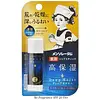What's inside
What's inside
 Key Ingredients
Key Ingredients

 Benefits
Benefits

 Concerns
Concerns

 Ingredients Side-by-side
Ingredients Side-by-side

Lanolin
EmollientSimmondsia Chinensis Seed Oil
EmollientDextrin Myristate
EmulsifyingEthylhexyl Methoxycinnamate
UV AbsorberHoney
HumectantRoyal Jelly Extract
Skin ConditioningButylene Glycol
HumectantPolysilicone-15
UV FilterTitanium Dioxide
Cosmetic ColorantParfum
MaskingWater
Skin ConditioningPolyglyceryl-2 Isostearate/Dimer Dilinoleate Copolymer
EmollientPolyglyceryl-3 Stearate/Isostearate/Dimer Dilinoleate Copolymer
Skin ConditioningHydrogenated Dimer Dilinoleic Acid
AbsorbentSynthetic Fluorphlogopite
Olea Europaea Fruit Oil
MaskingOctyldodecanol
EmollientDilinoleic Acid
EmollientBasic Red 1:1
Butyl Methoxydibenzoylmethane
UV AbsorberPentylene Glycol
Skin ConditioningMethoxycinnamic Acid
StabilisingDibutyl Lauroyl Glutamide
Skin ConditioningCalcium Aluminum Borosilicate
CI 15985
Cosmetic ColorantPolyglyceryl-2 Triisostearate
EmulsifyingSilica
AbrasivePotassium Hydroxide
BufferingPolyglyceryl-3 Triisostearate
EmollientCI 77492
Cosmetic ColorantCI 45380
Cosmetic ColorantRuby Extract
Skin ConditioningTin Oxide
AbrasiveLanolin, Simmondsia Chinensis Seed Oil, Dextrin Myristate, Ethylhexyl Methoxycinnamate, Honey, Royal Jelly Extract, Butylene Glycol, Polysilicone-15, Titanium Dioxide, Parfum, Water, Polyglyceryl-2 Isostearate/Dimer Dilinoleate Copolymer, Polyglyceryl-3 Stearate/Isostearate/Dimer Dilinoleate Copolymer, Hydrogenated Dimer Dilinoleic Acid, Synthetic Fluorphlogopite, Olea Europaea Fruit Oil, Octyldodecanol, Dilinoleic Acid, Basic Red 1:1, Butyl Methoxydibenzoylmethane, Pentylene Glycol, Methoxycinnamic Acid, Dibutyl Lauroyl Glutamide, Calcium Aluminum Borosilicate, CI 15985, Polyglyceryl-2 Triisostearate, Silica, Potassium Hydroxide, Polyglyceryl-3 Triisostearate, CI 77492, CI 45380, Ruby Extract, Tin Oxide
 Reviews
Reviews

Ingredients Explained
These ingredients are found in both products.
Ingredients higher up in an ingredient list are typically present in a larger amount.
Ethylhexyl Methoxycinnamate is an organic compound that provides UVB protection. It often goes by the more common name of octinoxate. It is created from methoxycinnamic acid and 2-ethylhexanol.
Ethylhexyl Methoxycinnamate absorbs UVB rays with wavelengths between 280-320 nm. UV absorbers protect your skin by using chemical reactions to convert UV rays into heat and energy.
UVB (290-320 nm) rays emit more energy than UVA rays. They are capable of damaging DNA, causing sunburns and are thought to be linked to skin cancer.
The state of Hawaii has banned sunscreens containing octinoxate due to its potential impact on coral reefs. More research is needed to bridge gaps in this research. The European Union allows higher levels of octinoxate in sunscreens than the US and Australia.
Ethylhexyl Methoxycinnamate is oil soluble. It is not stable and may lose efficacy when exposed to sunlight.
Learn more about Ethylhexyl MethoxycinnamateLanolin is a wax secreted by animals with wool, such as sheep. It is a waterproof emollient.
Emollients help soften and moisturize the skin by creating a film. This film prevents moisture from escaping, helping the skin stay hydrated.
Unlike true fats, lanolin contains sterol esters instead of glycerides. It also contains fatty acids and alcohols.
Because lanolin comes from an animal, it is not considered vegan. Sheep secrete lanolin through sebaceous glands to help protect their skin from the environment.
The answer to this question depends on the brand itself. Being cruelty-free means a brand does not experiment or harm animals. We recommend looking into how brands source their lanolin. Lanolin is cruelty-free if it is gathered without harming the animal.
Learn more about LanolinThis oil comes from the seeds of the desert shrub called Jojoba. It is more commonly known as jojoba oil, a non-comedogenic oil.
Jojoba oil does not contain fragrance and has many fatty-acids, making it a great soothing ingredient.
It also contains Vitamin E, a great moisturizing ingredient. Vitamin E is also an antioxidant and protects your skin against oxidative damage.
This ingredient humectant properties, meaning it helps draw moisture from the air. This helps keep your skin hydrated.
While jojoba has antibacterial properties, it is only able to kill some strains of bacteria.
Studies also show it helps in wound healing. In fact, Indigenous cultures have used jojoba as a moisturizer and to help treat burns for centuries.
Fun fact: Jojoba oil similar to natural human skin sebum, so it has a great effect on dry skin. It is also promising with helping to regulate sebum production.
Due to its fatty acid content, Jojoba oil may not be fungal acne safe. We recommend speaking with a professional if you have any concerns.
Learn more about Simmondsia Chinensis Seed Oil